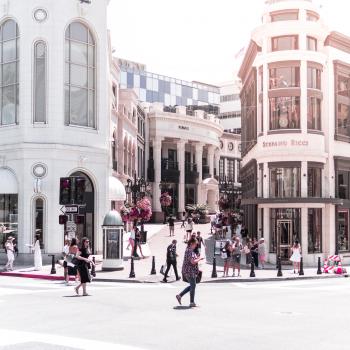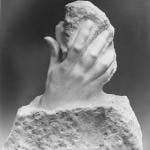 Twelve years ago, during the short months of our engagement before my husband and I were married, I had the pleasure of registering for wedding presents.
Twelve years ago, during the short months of our engagement before my husband and I were married, I had the pleasure of registering for wedding presents.
As a young child, I had watched all three of my older sisters select china, crystal, and sterling at Delta East-West gift shop owned by Helen Ward Nicholas and located on Main Street in my hometown.
I watched them unwrap the towers of presents that resulted, invariably wrapped in slick white or shiny silver paper. They set out the gleaming wares on the dining-room table, the engraved calling cards of the givers—“Dr. and Mrs. Shelby Truesdale III,” say—nestled among them for visitors’ inspection.
My sister Beth chose Pembroke china by Aynsley (pronounced Pem-brook), at the center of which was an illustration of a blue bird with a fine sharp beak. My sisters Janice and June, married in 1974 and 1975, each selected Lunt’s Chantilly as their sterling pattern.
Throughout the long desert of my twenties, I had seen more displays of wedding presents than I could count: Waterford toasting goblets, Wallace Rose Point iced-tea spoons, starched white linen cocktail napkins that had been hemstitched by ten-year-olds in some sweatshop in Uttar Pradesh.
And I had seen them used, as well: I had sat at Sunday afternoon dinner tables with crisp napkins on my lap, trying to pick up asparagus spears from serving trays with silver tongs, and delicately placing hot yeast rolls on the bread plate to my left. I’d been served innumerable mimosas in pewter mint julep cups, though never the namesake drink.
By the time I married, at thirty-one, I was an exile from the South, with a postmodern family scattered across the country, and no dining table where presents might be displayed.
Even though I was of impossibly advanced age—so I thought at the time—I had pranced through life with few possessions other than books and could have used some practical items to outfit a home.
The tendrils of tradition sought me out, even from afar—china, crystal, and hemstitched cocktail napkins I had waited so long for and wanted. The phone rang one day and it was none other than Mrs. Nicholas, calling to let me know that people from my hometown had called and wanted to know what patterns I had selected.
As the packages arrived in the mail in D.C., I felt saved, like a prodigal finally come home. At last, and despite all, I had arrived at the pinnacle of Southern womanhood, with its attendant accouterments.
My china: Haviland’s Symphony Gold. My crystal: Waterford Lismore. (I’m reminded, fondly, of Kelly Foster’s Good Letters post that trumpets the virtues of gracious living.)
At some point during my protracted years of singleness, brides apparently stopped caring about china and crystal—a trend that seems only to have advanced in the decade since my wedding. According to a July 11, 2012 release from TheKnot.com and WeddingChannel.com, only twenty-nine percent of couples registered for formal/fine china.
At least from my admittedly informal canvas, wedding registries now seem far more devoted to high-end cookware, small appliances, and particle-board closet organizational systems. All fine, I suppose—but all also catering to the stereotype of the chip and dip lounge lizard, acquiring and consuming. Nothing to gleam, behind glass, under shimmering light, in the corner dark of the dining room—mysteries for a little future daughter to dream on.
As far as home entertaining and décor goes, the bulk of my friends can be divided roughly into two styles: The devotees of mid-century modern design, who want to array their houses like Mad Men but with a few kitsch touches—Barcelona chairs and flokati rugs and ironic cocktail shakers, vintage kids’ lunchboxes and passé action figures.
In the other category, houses are arrayed as temples to Pottery Barn with plain wood tables, homespun Shaker-styled accessories, and Caipirinhas cocktails served in heavy Mexican glass tumblers.
One mode bespeaks of irony, the other authenticity. And isn’t it interesting that these would be the two poles folks gravitated toward?
I lived on this earth for more than forty years before I heard upper-middle and middle-class Americans start talking about their belongings as a matter of curating one’s collections. (See any recent issue of Real Simple if you don’t believe me.)
Amid them there appears to be no place for sterling candlesticks placed atop an Irish linen runner, a splash of claret in a small, delicate, tulip-shaped glass. Have you noticed how huge plates and glasses have become these days? As though clumsy Cyclopses inhabit our houses.
Our fear of formality seems to stem from a couple sources: One is the wish, socially, to appear Teflon-cool, casual, above all that earnest feeling and hard work that fine-china entertaining requires. We do not, it seems, want to be our lace-curtained Irish grandmothers, back in Birmingham or Levittown, sitting on plastic-covered brocade.
We want entertaining to be effortless, the equivalent of Erica Jong’s famous zipless fuck—since decorating and real estate are as pornographic as anything else today—free of the strictures of authority, but also those of feeling.
To entertain formally is a matter of labor and love and a submission to the belief that the ritual of the celebration matters. It is, in the end, an act of kenotic love and one available to the faithful and secular alike.
Yesterday afternoon I threw a baby shower for a young neighborhood friend. I have neither curated possessions nor endless casual space, but I did array my full set of china cups and saucers on a snowy embroidered Lebanese cloth. I set out my mother’s sterling, pattern: Lunt, William and Mary.
It felt, in some ways, that I was being old-fashioned. But it also felt like an act of daring, an act, somehow, of righteous rage: I have good china, and I’m not afraid to use it.















